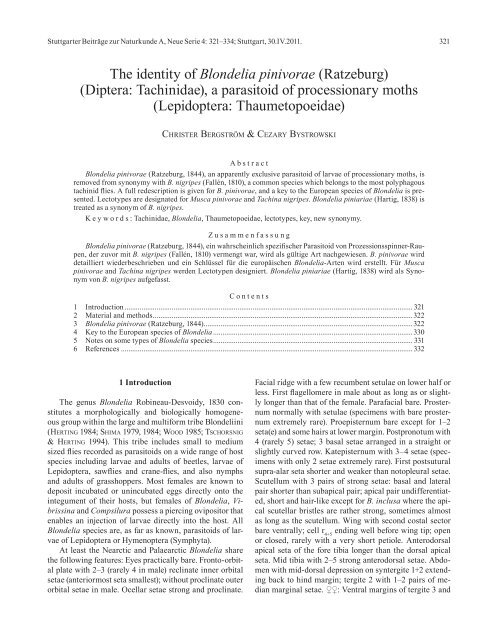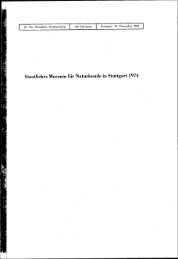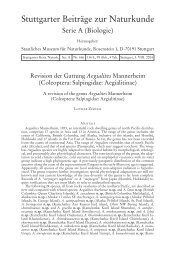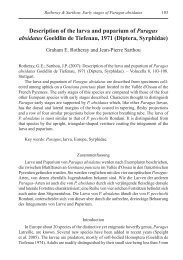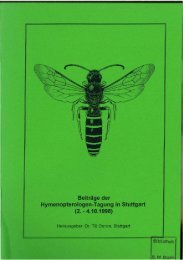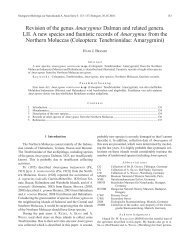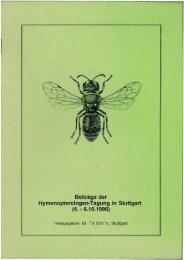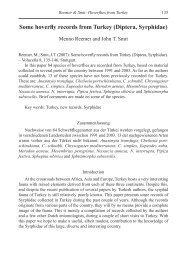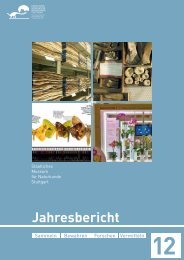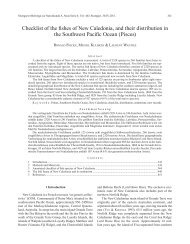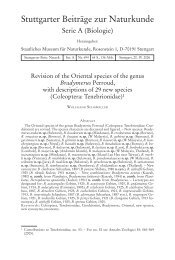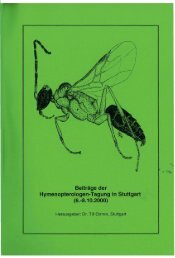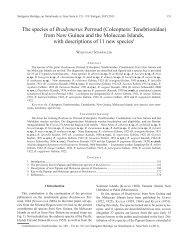(Ratzeburg) (Diptera: Tachinidae), a parasitoid of processionary moths
(Ratzeburg) (Diptera: Tachinidae), a parasitoid of processionary moths
(Ratzeburg) (Diptera: Tachinidae), a parasitoid of processionary moths
- No tags were found...
Create successful ePaper yourself
Turn your PDF publications into a flip-book with our unique Google optimized e-Paper software.
BERGSTRÖM & BYSTROWSKI, IDENTITY OF BLONDELIA PINIVORAE 325(along the black longitudinal mid-stripe) and laterally,erect or semi-erect on tergites 4 and 5. Tergite 2 with 2–4median and 1–(2) lateral marginal seta(e) on each side.Tergite 3 dorsally with 2–4 median and 2 lateral marginalsetae on each side, with 2 (rarely 3) median discal and 0–1lateral discal setae on each side. Tergite 4 with a completerow <strong>of</strong> 8–12 marginal setae, dorsomedially normally with2–4 strong discal setae <strong>of</strong>ten mixed with some additionalsetulae, rarely with as many as 6 strong setae, but medialdiscal setae always well separated from 1–3 lateral discalsetae. Tergite 5 with numerous discal setae, sometimes arrangedin 2–3 more or less irregular rows, and with marginalsetae at the tip.Male terminalia (Figs. 7–9): Sternite 5 about as wide aslong; basal plate long and strongly arched; anterior marginevenly rounded except for a small indentation at midpoint;posterior margin with a U-shaped incision, basallywith a narrowing, reaching to about middle <strong>of</strong> that segment;maximal width <strong>of</strong> incision as wide as or slightlywider than the width <strong>of</strong> the posterior lobe at that point;posterior lobe on surface with numerous setulae <strong>of</strong> varyingsize, medioapical margin densely short-haired. Sternite6 well developed, strongly asymmetrical. Tergite 6rather weakly sclerotized, widely constricted at the middleor separated into two hemitergites, rarely with someweak hairs along inner posterior margin; spiracle 6 situatedin membrane close to lower margin <strong>of</strong> segment 7 + 8.Segment 7 + 8 narrow, with numerous setulae; spiracle 7above, in an almost dorsolateral position, close to the anteriormargin <strong>of</strong> that segment. Epandrium in dorsal viewapproximately twice (1.8–2.0 times) as wide as long. Cercirobust, in lateral view widest at about middle with ventralmargin almost straight in apical half, in dorsal viewwide for a long distance and tapering shortly before apex,3.7–4.0 times as long as wide at level <strong>of</strong> beginning <strong>of</strong> apicalcleft; cleft about 0.25–0.30 times as long as basal suture.Surstylus distinctly shorter than cerci, in lateral viewsubrectangular, its tip evenly rounded with setulae in thedorsodistal portion, some <strong>of</strong> them noticeably long. Pregonitewith 4–5 hairs in apical portion. Postgonite narrow,hook-like, with 2–3 sensorial hairs, membranous apically.Intermedium long and narrow. Basiphallus without basalprojection; epiphallus distinctly sclerotized, insertedbasally. Ventral plate <strong>of</strong> distiphallus densely covered withspinules; lateroventral lobes insignificantly developed.Body length: 8.4–11.2 mm [10.9] (n = 17).Female (differences to male):Frons at narrowest point 0.32–0.37 [0.36] times (n = 17)as wide as head in dorsal view. Interfrontal area at midpoint0.6–0.7 times as wide as the corresponding parafrontalarea. Parafrontal area with a row <strong>of</strong> [4]5–7 frontalsetae; 2 outer proclinate orbital setae and 2 inner reclinateorbital setae (the posteriormost seta smaller and <strong>of</strong>tenslightly lateroclinate). Inner vertical seta about 0.8 <strong>of</strong>eye-height; outer vertical setae well developed, about halfas long as inner vertical seta and also longer and strongerthan postocellar setae. Parafacial at its narrowest point(actual width) 0.31–0.38 [0.34] times (n = 17) as wide as themaximum width <strong>of</strong> the face (including the facial ridges).First flagellomere 1.62–1.97 [1.72] times (n = 14) as longas pedicel. Legs: Claws and pulvilli on fore legs about aslong as tarsal segment 5, the latter 1.5–1.6 times as long astarsal segment 4. Abdomen: Ventral margins <strong>of</strong> tergites 3and 4 raised, forming a sharp ventral keel with 5–8 ratherlong but still stout spines at the posterior edges <strong>of</strong> tergites3 and 4.Ground vestiture dorsally on tergites 3 and 4 recumbentalso in the dorsomedial region, partly erect on tergite5. Tergite 2 with 2 median and 1 lateral marginal seta(e);tergite 3 with 2 median and 0–1 lateral marginal setae,2(rarely 3) median discal setae and 0–1 [0] lateral discalsetae; tergite 4 with a complete row <strong>of</strong> 8–10 [10] marginalsetae, dorsomedially normally with 2 strong medial discalsetae (rarely without) and 0–1 [0] lateral discal setae.Tergite 5 with fewer discal setae compared to male, arrangedin two rows in the posterior ⅔ <strong>of</strong> that segment.Female terminalia (Figs. 13, 17): Sternite 5 with posteriorhalf triangular in caudal view, somewhat membranousalong mid line, anterior half with a long and narrowinvagination concealed below sternite 4. Tergite 6 short,entire, slightly constricted at middle, with numerous hairsalong posterior margin. Sternite 6 in lateral view modifiedinto a distinct downcurved hook, apex in caudal viewabout twice as long as wide at middle, anterior invaginationfairly membranous with two sensorial pits (sensillatrichodea) at base. 6 th and 7 th spiracles in the membrane betweentergite 6 and sternite 6. Tergite 7 divided into twohemitergites. Sternite 7 with posterior part modified intoa downcurved hook-like piercer, basal lateral part differentiatedinto a wide and mostly stoutly sclerotized bridgefused to tergite 7, a minute anterior invagination withtwo sensorial pits. Tergite 8 divided into two small hemitergites,subtriangular in basal half and narrowly extendedposteriorly. Sternite 8 long and narrow (sometimes apparentlyshort due to the membranous apical part). Epiproctpresent. Hypoproct densely covered by microtrichia, lingulaelong and wide in dorsal view, extending parallel tothe narrow extension <strong>of</strong> tergite 8 and approaching its subtriangulararea. Cerci short.DistributionB. pinivorae is mainly recorded from Sweden (Ölandand Gotland), but as the species is also known from Germany(type material) and Turkey, it is most probably widespreadin Europe.
326 STUTTGARTER BEITRÄGE ZUR NATURKUNDE A Neue Serie 4Figs. 1–4. Blondelia spp., ♂, head, frontal (1, 3) and lateral (2, 4) view. – 1, 2. B. pinivorae. 3, 4. B. nigripes. – Scale: 1 mm.
BERGSTRÖM & BYSTROWSKI, IDENTITY OF BLONDELIA PINIVORAE 327Figs. 5–6. Blondelia spp., ♂, abdomen, dorsal view. 5. B. pinivorae. 6. B. nigripes. – Scales: 1 mm.BiologyBlondelia pinivorae is probably, based on the availableinformation, a principally univoltine and almost monophagous<strong>parasitoid</strong> <strong>of</strong> larvae <strong>of</strong> <strong>processionary</strong> <strong>moths</strong> (Lepidoptera:Thaumetopoeidae). However, it cannot be ruledout that it at least occasionally needs an alternate host t<strong>of</strong>ulfil its life cycle. Flight period in Sweden normally fromlate May to end <strong>of</strong> July, but specimens reared from cocoonsoccasionally emerge from late August to late September.A total <strong>of</strong> 99 Swedish specimens <strong>of</strong> B. pinivorae havebeen examined in this study: 43 specimens were rearedfrom the northern pine <strong>processionary</strong> moth Thaumetopoeapinivora (Treitschke, 1834) and 56 specimens werecollected with simple emergence traps or glue traps fromlocalities infested by this host (56). Most specimens originatefrom a rearing experiment in Gotland (LARSSON 2006),but a few are also from Öland (FORD et al. 2000, as B. nigripes).The Gotland population <strong>of</strong> T. pinivora has a twoyeardevelopment with parallel cohorts (year clas ses). Thehost larvae feed from April to end <strong>of</strong> July, which indicatesthat flies emerging from one cohort will parasitize larvae<strong>of</strong> the parallel cohort. Cohorts with high larval densitiesonly occur in even years and are followed by a relativelylarge population <strong>of</strong> B. pinivorae in uneven years ( LARSSON2006).One or two (rarely three) full-grown tachinid larvaecome out from each host (5 th instar larva, prepupa or pupa).The pupariation takes place inside the host cocoon, or inits close vicinity. The most probable scenario is that thetachinid hibernates in its puparial state inside the cocoonclose together with the dead host pupa (in the ground), butthis has not been shown in LARSSON’s study. The adult fliesemerge under natural conditions from end <strong>of</strong> May to mid
328 STUTTGARTER BEITRÄGE ZUR NATURKUNDE A Neue Serie 4Figs. 7–12. Blondelia spp., ♂, hypopygium in lateral (7, 10), caudal (8, 11) and dorsal (9, 12) view. – 7–9. B. pinivorae. 10–12. B. nigripes. – Scales: 0.25 mm.
BERGSTRÖM & BYSTROWSKI, IDENTITY OF BLONDELIA PINIVORAE 329Figs. 13–18. Blondelia spp., ♀, terminalia in lateral (13–15) and oblique dorsal view (16), sternite 6 in caudal view (17, 18). –13, 17. B. pinivorae. 14–16, 18. B. nigripes. – Scales: 0.5 mm.
330 STUTTGARTER BEITRÄGE ZUR NATURKUNDE A Neue Serie 4July the following year. However, if the Swedish population<strong>of</strong> B. pinivorae is monophagous (restricted to T.pinivora), it is not easy to explain the occurrence <strong>of</strong> newlyemerged flies in autumn (August – September). One possibilityis that they originate from perpetual host larvaewhose development has been influenced by an abnormalrearing temperature.We have also examined ten Turkish specimens rearedfrom the cedar <strong>processionary</strong> moth Thaumetopoea[= Traumatocampa] ispartaensis Doğanlar & Avcı, 2001,published as Blondelia nigripes by AVCI & KARA (2002).This material turned out to be B. pinivorae, as well as thetwo specimens in NHMW reared from T. pinivora (publishedby HERTING 1960 as B. nigripes). BAER’s (1921)record <strong>of</strong> B. nigripes from T. pinivora refers to the originalmaterial <strong>of</strong> B. pinivorae <strong>of</strong> RATZEBURG (1844). So it is obvious,that B. pinivorae represents the only species <strong>of</strong> Blondeliafrom those two <strong>processionary</strong> <strong>moths</strong>.The winter pine <strong>processionary</strong> moth Thaumetopoeapityocampa (Denis & Schiffermüller, 1775) is a commonlyreared host which is primarily attacked by Phryxe caudata,but frequently also by Compsilura concinnata, andmore rarely by Exorista segregata and E. larvarum (e. g.BILIOTTI 1956, 1958; DÉMOLIN 1970; KARA & TSCHORSNIG2002; LÓPEZ-SEBASTIÁN et al. 2007; CERRETTI & TSCHORSNIG2010). The first author has also examined an extensive materialreared from T. pityocampa kindly sent to him fromANDREA BATTISTI (University <strong>of</strong> Padova). This material,apart from numerous specimens <strong>of</strong> P. caudata, also includedmany specimens <strong>of</strong> C. concinnata and also a singlespecimen <strong>of</strong> E. larvarum (from Sardinia). There is only asingle literature record <strong>of</strong> Blondelia nigripes from T. pityocampa(HERTING 1960). Without a study <strong>of</strong> the specimen(s),it cannot be decided if it really refers to B. nigripes or toB. pinivorae, but Blondelia is surely <strong>of</strong> negligible importanceas <strong>parasitoid</strong> <strong>of</strong> T. pityocampa.The oak <strong>processionary</strong> moth Thaumetopoea processionea(Linnaeus, 1758) is rarely recorded as a host forBlondelia nigripes (DOWDEN 1933, ZEEGERS 1997). Thefirst author has dissected the single male specimen fromthe ZEEGERS material and it is actually representing B. nigripes,although the genitalia are slightly aberrant. However,other tachinid species which are <strong>of</strong>ten reared in largenumbers from T. processionea, especially Carcelia iliacaand Pales processioneae (TSCHORSNIG 1996, CERRETTI &TSCHORSNIG 2010), indicate that Blondelia is an uncommon<strong>parasitoid</strong> for this host.4 Key to the European species <strong>of</strong> BlondeliaBlondelia pinivorae is very similar to B. nigripes in outermorphology and was therefore not recognized as a separate speciesin the available keys. However, it is – although the bodysize is widely overlapping – normally a distinctly larger species.Overlapping are also the extent <strong>of</strong> the abdominal pruinosity, thewidth <strong>of</strong> the frons in dorsal view, and the width <strong>of</strong> the first flagellomerein lateral view, but these features may nevertheless beuseful in certain cases and are therefore included in the followingkey, which is modified from TSCHORSNIG & HERTING (1994):1 Palpus yellow. Scutellum with long and crossed apical setae.First flagellomere in ♂ 2.8–3.8, in ♀ 1.9–2.8 times as long aspedicel. Tergites 3 and 4 with bands <strong>of</strong> pruinosity in anterior1/5– 2 /5. ..................................................................... B. inclusa– Palpus black to brownish yellow. Scutellum without or withonly hair-like apical setae. First flagellomere in ♂1.76–2.50,in ♀ 1.43–1.97 times as long as pedicel. Tergites 3 and 4 withbands <strong>of</strong> pruinosity in anterior 3 /5– 5 /6. ................................. 22 Body size 8.4–11.2 mm. Parafacial in frontal view slightlynarrowing below; actual width at narrowest point in male0.28–0.31, in female 0.31–0.38 times as wide as maximalwidth <strong>of</strong> face (including the facial ridge) (Fig. 1). First flagellomerein lateral view narrower than actual width <strong>of</strong> parafacialat middle (Fig. 2). Wing veins and microtrichia stronglyinfuscated (not visible in sun bleached specimens). Fronsin ♂ at its narrowest point 0.24–0.30 times as wide as headin dorsal view, in ♀ 0.32–0.37 times. Abdominal pruinositycovering the anterior 3 /4– 5 /6 <strong>of</strong> tergite 3, 2 /3– 3 /4 <strong>of</strong> tergite 4,and 3 /5– 2 /3 <strong>of</strong> tergite 5 (Fig. 5). – ♂: Tergite 3 with 2–4 medianand 2 lateral marginal setae on each side, 2 (rarely 3) mediandiscal setae; tergite 4 normally with 2–4 strong medialdiscal setae mixed with some additional setulae but alwayswell separated from 1–3 lateral discal setae (Fig. 5). Terminalia:Epandrium in dorsal view 1.8–2.0 times as wide aslong (Fig. 9); cerci robust, in lateral view with ventral marginalmost straight in apical half (Fig. 7), in dorsal view wideover a long distance (tapering shortly before apex), 3.7–4.0 times as long as wide at level <strong>of</strong> beginning <strong>of</strong> apical cleft(Fig. 8); lateroventral lobes <strong>of</strong> distiphallus vaguely expandedin the medioventral region (Fig. 7). – ♀: Tergite 3 with 2median and 0–1 lateral marginal setae, 2 median and 0–1 [0]lateral discal setae; tergite 4 dorsomedially with 0–2 strongmedial and 0–1 [0] lateral discal setae; tergite 5 dorsally with2 medial setae separated from 1–2 seta on each side. Terminalia:Sternite 6 in lateral view with a long hook-like ventralprojection, in caudal view with apex about twice as long aswide at middle; sternite 7 long and strong, anteriorly with ashallow ventral incurvature (Figs. 13, 17)......... B. pinivorae– Body size 5.3–9.6 mm. Parafacial in frontal view distinctlynarrowing below; actual width at narrowest point in male0.18–0.26, in female 0.22–0.28 times as wide as maximalwidth <strong>of</strong> face (Fig. 3). First flagellomere normally as wideas or wider than actual width <strong>of</strong> parafacial at middle (Fig. 4).Wing veins and microtrichia yellowish or light brown.Frons slightly narrower, in male at its narrowest point 0.21–0.28 times as wide as head in dorsal view, in female 0.29–0.34 times. Abdominal pruinosity slightly less developed,covering the anterior 3 /5– 3 /4 <strong>of</strong> tergites 3 and 4, and 1 /2– 3 /5 <strong>of</strong>tergite 5 (Fig. 6). – ♂: Tergite 3 with at least 4 median and2 lateral marginal setae on each side (sometimes forming acomplete row), 2–4 (rarely 6) median discal setae; tergite 4usually with a complete row <strong>of</strong> strong discal setae, sometimeswith a second row (Fig. 6). Terminalia: Epandriumin dorsal view 1.4–1.6 times as wide as long (Fig. 12); cercimore slender, in lateral view with ventral margin somewhatincurved in apical half (Fig. 10), in dorsal view wide over ashorter distance (tapering well before apex), 5.0–5.5 timesas long as wide at level <strong>of</strong> beginning <strong>of</strong> apical cleft (Fig. 11);
BERGSTRÖM & BYSTROWSKI, IDENTITY OF BLONDELIA PINIVORAE 331lateroventral lobes <strong>of</strong> distiphallus markedly expanded in themedioventral region (Fig. 10). – ♀: Tergite 3 with 2 medianand 1–2 lateral marginal setae, and 2 median and 1 (sometimesweak) lateral discal setae; tergite 4 occasionally witha complete row <strong>of</strong> strong discal setae but then the row mostlyconsisting <strong>of</strong> 2–4 strong medial setae, some erect mediolateralsetulae and 2–3 lateral discal setae <strong>of</strong> different size;tergite 5 dorsally with 10–12 equally sized discal setae forminga complete row. Terminalia: Sternite 6 in lateral viewwith a short projection, in caudal view with apex about aslong as wide at middle; sternite 7 weaker, anteriorly with adeeper ventral incurvature (Figs. 14–16, 18). ......B. nigripes5 Notes on some types <strong>of</strong> BlondeliaTachina nigripes Fallen, 1810[FALLÉN 1810: 270]Type material: One syntype (♀) is available in theFALLÉN collection in NHRS, drawer 13 (1) and two syntypes(♀♀) are available in the <strong>Diptera</strong> Scandinaviae Collectionin MZLU, drawer 20 (10). The original description(partly in Swedish) mentions only the female. Themale gender was included later by FALLÉN (1820: 13). Thetype locality is apparently Kiviks Esperöd, Mellby parish,Scania, Sweden, as indicated by ZETTERSTEDT (1844: 1059)“Hab. in Scandinavia, 12 Jul.–18 Sept., passim, in copula;scilicet in Scania in graminosis ad Esperöd in paræc.Mellby”.Three specimens, 2 ♀♀ and 1 ♂ were found under thename Tachina nigripes in the FALLÉN collection in NHRS:One female is mounted on an old strong pin and bears thefollowing labels: “[handwritten faded ink label <strong>of</strong> FAL-LÉN] T. nigri / pes ♀ Fall. // Lectotype ♀ / Tachina / nigripesFallén 1810 / des. BERGSTRÖM 2008”. I hereby designatethis female from Sweden as lectotype <strong>of</strong> Tachinanigripes Fallén, 1810. It is in fairly good condition exceptfor severe tears in both wings. The second female bearsa FALLÉN label “Tachina /nigripes /♂ Fallén”, i. e. it wasoriginally misidentified as male. The third specimen, acorrectly associated male, is unlabelled. The misidentifiedfemale and the male are not regarded as belonging to thesyntype series.The paralectotypes in MZLU are both mounted on oldstrong pins <strong>of</strong> FALLÉN type. The first female is labelled asfollows: “[light blue tag (= Sweden, Skåne, Mellby, Esperödnear Kivik)] // [handwritten ZETTERSTEDT label] T. nigripes/ ♀ Mus. Fall. // Paralectotype ♀ / Tachina nigripes/ Fallén 1810 / des. BERGSTRÖM 2004”. The second, originallyunlabelled female is labelled: “Paralectotype ♀ /Tachina nigripes / Fallén 1810 / des. BERGSTRÖM 2004”.According to DOWDEN (1933), who refers to an unpublishedwork <strong>of</strong> SELLERS, two cotypes, a male and a female,<strong>of</strong> nigripes Fallén are present in MEIGEN’s collection inNHMW. The male was designated by SELLERS as the truenigripes while the female was referred to as B. piniariaeHartig. The type designation <strong>of</strong> SELLERS (in DOWDEN l. c.)has not been accepted by recent entomologists, apparentlybecause the original description explicitly refers to thefemale gender alone. HERTING & DELY-DRASKOVITS (1993)also referred to the type as a female from Sweden.Identity: Tachina nigripes (Fallén, 1810) is a valid species<strong>of</strong> Blondelia Robineau-Desvoidy 1830 as currentlyunderstood.Tachina piniariae Hartig, 1838[HARTIG 1838: 283]Type material: Eight syntypes, which are available inthe collection HARTIG in ZSM have been examined by thefirst author. The original description <strong>of</strong> Tachina piniariaewas based on an unspecified number <strong>of</strong> specimens representingboth genders, all reared from Bupalus piniaria(Linnaeus, 1758) (as Geometra piniariae) and Abraxasgrossulariata (Linnaeus, 1758) (as Geometra grossulariata).Type locality: probably Germany.These syntypes are labelled as follows (measurementsmade by the first author are given in square brackets at theend <strong>of</strong> each type); four <strong>of</strong> the eight specimens were originallylabelled as types:♂, with puparium; 210 // [printed] aus dem Kasten: / Tachiniden-Typen/ von HARTIG und RATZEBURG // [printed and handwrittenred label] Type von HARTIG / Lydella R.-D. / piniariaeHtg // [handwritten HARTIG label with a black curled/coiledrim] piniariae / n. // [handwritten and printed label with a blackframe] Lydella 210/212 / nigripes Fall. / Det. SELLERS // [handwritten]Blondelia ♂ / nigripes Fall. / B. HERTING det. ’79 / odpiniariae Htg. / nicht trennbar. [frons/head width = 0.26, actualwidth <strong>of</strong> parafacial at narrowest point (pafc w) / maximal width<strong>of</strong> facial (fc w) = 0.21].♂, with puparium and remains <strong>of</strong> host pupa; 211 // [printed]aus dem Kasten: / Tachiniden-Typen / von HARTIG und RATZEBURG// [printed and handwritten red label] Type von / HARTIG // [handwrittenHARTIG label with a black curled/coiled rim] piniariae /n. // Lydella 209/211 / piniariae Hrtg. / Det. SELLERS // [handwritten]Blondelia ♂ / nigripes Fall. / od piniariae Htg. / det. B.HERTING, ’79. [frons/head = 0.27, pafc w/fc w = 0.21].♂, with puparium and host pupa; 212 // [printed] aus demKasten: / Tachiniden-Typen / von HARTIG und RATZEBURG //[printed and handwritten red label] Type von / HARTIG // [handwrittenHARTIG label with a black curled/coiled rim] piniariae/ n. // Lydella 210/212 / nigripes Fall. / Det. SELLERS // [handwritten]Blondelia ♂ / nigripes Fall. / od piniariae Htg. / det. B.HERTING, ’79. [frons/head = 0.27, pafc w/fc w = 0.20].♀, with puparium; 209 // [printed] aus dem Kasten: / Tachiniden-Typen/ von HARTIG und RATZEBURG // [printed and handwrittenred label] Type von / HARTIG // [handwritten HARTIG labelwith a black curled/coiled rim] piniariae / n. // Lydella 209/211 /piniariae Hrtg. / Det. SELLERS // [handwritten] Blondelia ♀ / nigripesFall. / od piniariae Htg. / det. B. HERTING, ’79. [frons/head= 0.33, pafc w/fc w = 0.23].♂; (green) 406 // [printed] aus dem Kasten: / Tachiniden-Typen / von HARTIG und RATZEBURG // [handwritten HARTIG labelwith a black curled/coiled rim] piniariae / n. // [handwritten]Blondelia ♂ / nigripes Fall. / od piniariae Htg. / det. B. HERTING,’79. [frons/head = 0.25].
332 STUTTGARTER BEITRÄGE ZUR NATURKUNDE A Neue Serie 4♀; (red) 499 // [printed] aus dem Kasten: / Tachiniden-Typen /von HARTIG und RATZEBURG // [handwritten HARTIG label witha black curled/coiled rim] piniariae / n. // [handwritten] Blondelia♀ / nigripes Fall. / od piniariae Htg. / det. B. HERTING, ’79.[frons/head = 0.30].♀; [printed] aus dem Kasten: / Tachiniden-Typen / vonH ARTIG und RATZEBURG // [handwritten HARTIG label with a blackcurled/coiled rim] piniariae / n. // [handwritten] Blondelia ♀ /nigripes Fall. / od piniariae Htg. / det. B. HERTING, ’79. [frons/head = 0.32].♂, head missing, with puparium; (blue) 904 // [printed] ausdem Kasten: / Tachiniden-Typen / von HARTIG und RATZEBURG //[handwritten HARTIG label with a black curled/coiled rim] piniariae/ n. // [handwritten] Blondelia ♂ / nigripes Fall. / od piniariaeHtg. / det. B. HERTING, ’79.MIK & WACHTL (1895) treated Dexodes piniariae( Hartig) as a valid name although Tachina nigripes Fallénwas regarded a valid senior synonym. This opinion washowever not accepted by BEZZI & STEIN (1907), BAER(1921) and STEIN (1924) who treated B. piniariae as a synonym<strong>of</strong> B. nigripes. However, DOWDEN (1933) claimed thatB. nigripes and B. piniariae represented two distinct species.This opinion was supported by rearing experimentsshowing that specimens reared from Bupalus piniaria(Geometridae) apparently have habits and life historiesdifferent from those reared from Lymantria dispar andEuproctis chrysorrhoea (Lymantriidae). For example, itwas shown that under natural conditions larvae <strong>of</strong> Bupaluspiniaria were parasitized by B. piniariae but not by B. nigripes.Furthermore, according to DOWDEN (l. c.), the twospecies could easily be distinguished by the relationship<strong>of</strong> the width <strong>of</strong> the frons at its narrowest point to the width<strong>of</strong> head at its widest part. This ratio in B. nigripes rangesfrom 0.224–0.245 in the males, and from 0.293–0.303in females, while B. piniariae has an average range from0.274–0.286 in the males, and from 0.324–0.333 in females.However, the results are not trustworthy becausemost specimens examined by us shows intermediate valuesbetween the limits presented by DOWDEN who refersto measurements performed by SELLERS. The confusionincreased when the first author examined the eight syntypesavailable in HARTIG’s collection in ZSM (see above).SELLERS who has examined the syntypes regarded them torepresent two different species and it was later somehowassumed that the specimens that he determined to B. piniariaeare reared from Bupalus piniaria. There is, however,no information available on the labels which would indicatewhich specimens are reared from Bupalus piniariaor Abraxas grossulariata. Furthermore EMDEN (1954) als<strong>of</strong>ound that the number <strong>of</strong> intermediates between DOWDEN’slimits was far greater than the number falling within hisgroups and stated that there is insufficient morphologicalevidence for regarding B. nigripes and B. piniariae as separatespecies. However, because <strong>of</strong> the proposed differencesin host-range he treated them as two biological races<strong>of</strong> the same species B. nigripes. MESNIL (1962: 758), whorefers to EMDEN, understood B. piniariae as a subspecies<strong>of</strong> B. nigripes. HERTING (1984: 186) treated B. piniariae asecologically different from B. nigripes, but morphologicallyindistinguishable.We have examined numerous specimens <strong>of</strong> B. nigripesreared from various hosts, without finding morphologicalfeatures which would separate them from specimens rearedfrom Bupalus piniaria. The width <strong>of</strong> the frons at its narrowestpoint is surely not a stable character. Also the maleand female terminalia, when considering a large number<strong>of</strong> specimens, show no distinct differences. DOWDEN surelycould not really recognize B. pinivorae as a distinct species,and this fact makes it difficult to interpret some <strong>of</strong> theresults presented in his paper.We therefore, referring to the results presented above,advise that the name B. piniariae is treated in synonymywith B. nigripes. Nevertheless, we believe that the finaldecision on this question should be based on a careful molecular-geneticanalysis.6 ReferencesAVCI, M. & KARA, K. (2002): <strong>Tachinidae</strong> <strong>parasitoid</strong>s <strong>of</strong> Traumatocampaispartaensis from Turkey. – Phytoparasitica 30:361–364.BAER, W. (1921): Die Tachinen als Schmarotzer der schädlichenInsekten. Ihre Lebensweise, wirtschaftliche Bedeutung undsystematische Kennzeichnung. – Zeitschrift für angewandteEntomologie 7: 97–163.BEZZI, M. & STEIN, P. (1907): Cyclorrapha Aschiza. Cyclor raphaSchizophora: Schizometopa. – In: BECKER, T., BEZZI, M.,KERTÈSZ, K. & STEIN, P. (eds.): Katalog der paläarktischenDipteren 3: 828 pp.BILIOTTI, E. (1956): Biologie de Phryxe caudata Rond. (Dipt.Larvaevoridae) parasite de la chenille processionaire du pin(Thaumetopoea pityocampa Schiff.). – Revue de Pathologievégétale et d’Entomologie agricole de France 35: 50–65.BILIOTTI, E. (1958): Les parasites et prédateurs de Thaumetopoeapityocampa Schiff. (Lepidoptera). – Entomophaga 3:23–34.CERRETTI, P. & TSCHORSNIG, H.-P. (2010): Annotated host cataloguefor the <strong>Tachinidae</strong> (<strong>Diptera</strong>) <strong>of</strong> Italy. – Stuttgarter Beiträgezur Naturkunde A, Neue Serie 3: 305–340.DÉMOLIN, G. (1970): Programa ecológico internacional sobre la“processionaria del pino” Thaumetopoea pityocampa Schiff.– Boletín del Servicio de Plagas forestales 13: 111–117.DOWDEN, P. B. (1933): Lydella nigripes and L. piniariae, fly parasites<strong>of</strong> certain tree-defoliating caterpillars. – Journal <strong>of</strong>agricultural Research 46: 963–995.EMDEN, H. F. VAN (1954): On the status <strong>of</strong> Blondelia nigripesFallén and Blondelia piniariae Hartig (<strong>Diptera</strong>: <strong>Tachinidae</strong>).– Proceedings <strong>of</strong> the royal entomological Society <strong>of</strong> London(Series B) 23: 155–158.FALLÉN, C. F. (1810): Försök att bestämma de i Sverige funneflugarter, som kunna föras till slägtet Tachina. – Kongligasvenska Vetenskaps Akadademiens Nya Handlingar (2) 31:253–287.FALLÉN, C. F. (1820): Monographia Muscidum Sveciae. Part 2,pp. 13–24; Lundae [= Lund] (Berling).
BERGSTRÖM & BYSTROWSKI, IDENTITY OF BLONDELIA PINIVORAE 333FORD, T. H., SHAW, M. R. & ROBERTSON, D. M. (2000): Further hostrecords <strong>of</strong> some West Palaearctic <strong>Tachinidae</strong> (<strong>Diptera</strong>). – Entomologist’sRecord and Journal <strong>of</strong> Variation 112: 25–36.GUIMARÃES, J. H. (1971): Family <strong>Tachinidae</strong> (Larvaevoridae). –In: A catalogue <strong>of</strong> the <strong>Diptera</strong> <strong>of</strong> the Americas south <strong>of</strong> theUnited States 104: 333 pp.; São Paulo (Museu de ZoologiaUniversidade de São Paulo).HARTIG, T. (1838): Ueber die parasitischen Zweiflüger des Waldes.– Jahresberichte ueber die Fortschritte der Forstwissenschaftund forstlichen Naturkunde 1: 275–306.HERTING, B. (1957): Das weibliche Postabdomen der calyptratenFliegen (<strong>Diptera</strong>) und sein Merkmalswert für die Systematikder Gruppe. – Zeitschrift für Morphologie und Ökologieder Tiere 45: 429–461.HERTING, B. (1960): Biologie der westpaläarktischen Raupenfliegen(Dipt., <strong>Tachinidae</strong>). – Monographien zur angewandtenEntomologie 16: 188 pp.HERTING, B. (1984): Catalogue <strong>of</strong> Palearctic <strong>Tachinidae</strong> (<strong>Diptera</strong>).– Stuttgarter Beiträge zur Naturkunde, Serie A (Biologie)369: 228 pp.HERTING, B. (1987): Beiträge zur Kenntnis der paläarktischenRaupenfliegen (Dipt. <strong>Tachinidae</strong>), XVII. – Stuttgarter Beiträgezur Naturkunde, Serie A (Biologie) 408: 14 pp.HERTING, B. (1990): Beiträge zur Kenntnis der paläarktischenRaupenfliegen (Dipt. <strong>Tachinidae</strong>), XVIII. – Stuttgarter Beiträgezur Naturkunde, Serie A (Biologie) 455: 5 pp.HERTING, B. & DELY-DRASKOVITS, Á. (1993): Family <strong>Tachinidae</strong>.– In: SOÓS, Á. & PAPP, L. (eds.): Catalogue <strong>of</strong> Palaearctic <strong>Diptera</strong>,vol. 13, Anthomyiidae–<strong>Tachinidae</strong>, pp. 118–624; Budapest(Hungarian Natural History Museum).KARA, K. & TSCHORSNIG, H.-P. (2002): Host catalogue for theTurkish <strong>Tachinidae</strong> (<strong>Diptera</strong>). – Journal <strong>of</strong> applied Entomology127: 465–476.LARSSON, S. (2006): Massuppträdande av tallprocessionsspinnarenThaumetopoea pinivora på södra Gotland. – EntomologiskTidskrift 127: 1–7.LÓPEZ-SEBASTIÁN, E., TSCHORSNIG, H.-P., PUJADE-VILLAR, J., GUA-RA, M. & SELFA, J. (2007): Sobre los <strong>parasitoid</strong>es asociados alas fases de larva y pupa de la procesionaria del pino en cuatrobosques mediterráneos (España). – Boletín de Sanidadvegetal, Plagas 33: 53–60.MESNIL, L. P. (1962): Larvaevorinae (Tachininae). – In: LINDNER,E. (ed.): Die Fliegen der palaearktischen Region 64g,pp. 705–800.MIK, J. & WACHTL, F. A. (1895): Commentar zu den Arbeiten vonHARTIG und RATZEBURG über Raupenfliegen (Tachiniden).Aufgrund einer Revision der HARTIG’schen Tachiniden-Sammlung. – Wiener entomologische Zeitung 14: 213–250.O’HARA, J. E. (2002): Revision <strong>of</strong> the Polideini (<strong>Tachinidae</strong>) <strong>of</strong>America north <strong>of</strong> Mexico – Studia dipterologica, Supplement10: 170 pp.O’HARA, J. E. (2008): World genera <strong>of</strong> the <strong>Tachinidae</strong> (<strong>Diptera</strong>)and their regional occurrence. Version 4. http://www.nadsdiptera.org/Tach/Genera/Gentach_ver4.pdf.O’HARA, J. E., SHIMA, H. & ZHANG, C. (2009): Annotated catalogue<strong>of</strong> the <strong>Tachinidae</strong> (Insecta: <strong>Diptera</strong>) <strong>of</strong> China. –Zootaxa 2190: 1–236.O’HARA, J. E. & WOOD, D. M. (2004): Catalogue <strong>of</strong> the <strong>Tachinidae</strong>(<strong>Diptera</strong>) <strong>of</strong> America north <strong>of</strong> Mexico. – Memoirs onEntomology, international 18: IV + 410 pp.RATZEBURG, J. T. C. (1844): Die Forst-Insecten oder Abbildung undBeschreibung der in den Wäldern Preussens und der Nachbarstaatenals schädlich oder nützlich bekannt gewordenenInsecten; in systematischer Folge u. mit besonderer Rücksichtauf d. Vertilgung der Schädlichen. 3. Die Ader-, Zwei-, Halb-,Netz- und Geradflügler, VIII + 314 pp.; Berlin (Nicolai).SHIMA, H. (1979): Study on the tribe Blondeliini from Japan(<strong>Diptera</strong>: <strong>Tachinidae</strong>) I. – Kontyû 47: 126–138.SHIMA, H. (1984): Study on the tribe Blondeliini from Japan (<strong>Diptera</strong>,<strong>Tachinidae</strong>) V. The genera Blondelia Robineau-Desvoidyand Compsilura Bouché. – Kontyû 52: 540–552.SHIMA, H. (1997): Taxonomical notes on Oriental <strong>Tachinidae</strong>(Insecta, <strong>Diptera</strong>) I: Blondeliini. – Bulletin <strong>of</strong> the graduateSchool <strong>of</strong> social and cultural Studies, Kyushu University 3:169–186.STEIN, P. (1924): Die verbreitetsten Tachiniden Mitteleuropasnach ihren Gattungen und Arten. – Archiv für Naturgeschichte(A) 90: 1–271.TSCHORSNIG, H.-P. (1985): Taxonomie forstlich wichtiger Parasiten:Untersuchungen zur Struktur des männlichen Postabdomensder Raupenfliegen (<strong>Diptera</strong>, <strong>Tachinidae</strong>). – StuttgarterBeiträge zur Naturkunde, Serie A (Biologie) 383: 137 pp.TSCHORSNIG, H.-P. (1996): Parasitoide aus dem EichenprozessionsspinnerThaumetopoea processionea (Linnaeus) (Lepidoptera:Thaumetopoeidae). – Mitteilungen des entomologischenVereins Stuttgart 36: 105–107.TSCHORSNIG, H.-P. & HERTING, B. (1994): Die Raupenfliegen( <strong>Diptera</strong>: <strong>Tachinidae</strong>) Mitteleuropas: Bestimmungstabellenund Angaben zur Verbreitung und Ökologie der einzelnenArten. – Stuttgarter Beiträge zur Naturkunde, Serie A (Biologie)506: 170 pp.TSCHORSNIG, H.-P. & RICHTER, V. (1998): 3.54. Family <strong>Tachinidae</strong>.– In: PAPP, L. & DARVAS, B. (eds.): Contributions to a Manual<strong>of</strong> Palaearctic <strong>Diptera</strong> (with special reference to flies <strong>of</strong> economicimportance). Vol. 3. Higher Brachycera, pp. 691–827;Budapest (Science Herald).TSCHORSNIG, H.-P., RICHTER, V. A., CERRETTI, P., ZEEGERS, T.,B ERGSTRÖM, C., VAŇHARA, J., VAN DE WEYER, G., BYSTROWSKI,C., RAPER, C., ZIEGLER, J. & HUBENOV, Z. (2004): <strong>Tachinidae</strong>.– In: Fauna Europaea, http://www.faunaeur.org (availableonline 16.XII.2004).WOOD, D. M. (1985): A taxonomic conspectus <strong>of</strong> the Blondeliini<strong>of</strong> North and Central America and the West Indies (<strong>Diptera</strong>:<strong>Tachinidae</strong>). – Memoirs <strong>of</strong> the entomological Society <strong>of</strong>Canada 132: 130 pp.ZEEGERS, T. (1997): Sluipvliegen (<strong>Diptera</strong>: <strong>Tachinidae</strong>) vande Nederlandse eikenprocessierupsen. – EntomologischeBerichten, Amsterdam 57: 73–78.ZETTERSTEDT, J. W. (1844): <strong>Diptera</strong> Scandinaviæ disposita et descripta3: 895–1280; Lundæ [= Lund] (Lundberg).ZIEGLER, J. (1998): Raupenfliegen – seit RATZEBURG ein Forschungsthemain Eberswalde. Ein Bericht aus dem DeutschenEntomologischen Institut. – Eberswalder Jahrbuch fürHeimat-, Kultur- und Naturgeschichte 1998/99, pp. 273–281.
334 STUTTGARTER BEITRÄGE ZUR NATURKUNDE A Neue Serie 4Authors’ addresses:CHRISTER BERGSTRÖM (corresponding author), Säves väg 10, 75263 Uppsala, Sweden;e-mail: christer.bergstrom@zeta.telenordia.seCEZARY BYSTROWSKI, Forest Research Institute, ul. Braci Leśnej 3, 05-090 Raszyn, Poland;e-mail: c.bystrowski@ibles.waw.plManuscript received: 3.V.2010, accepted: 26.VII.2010.


